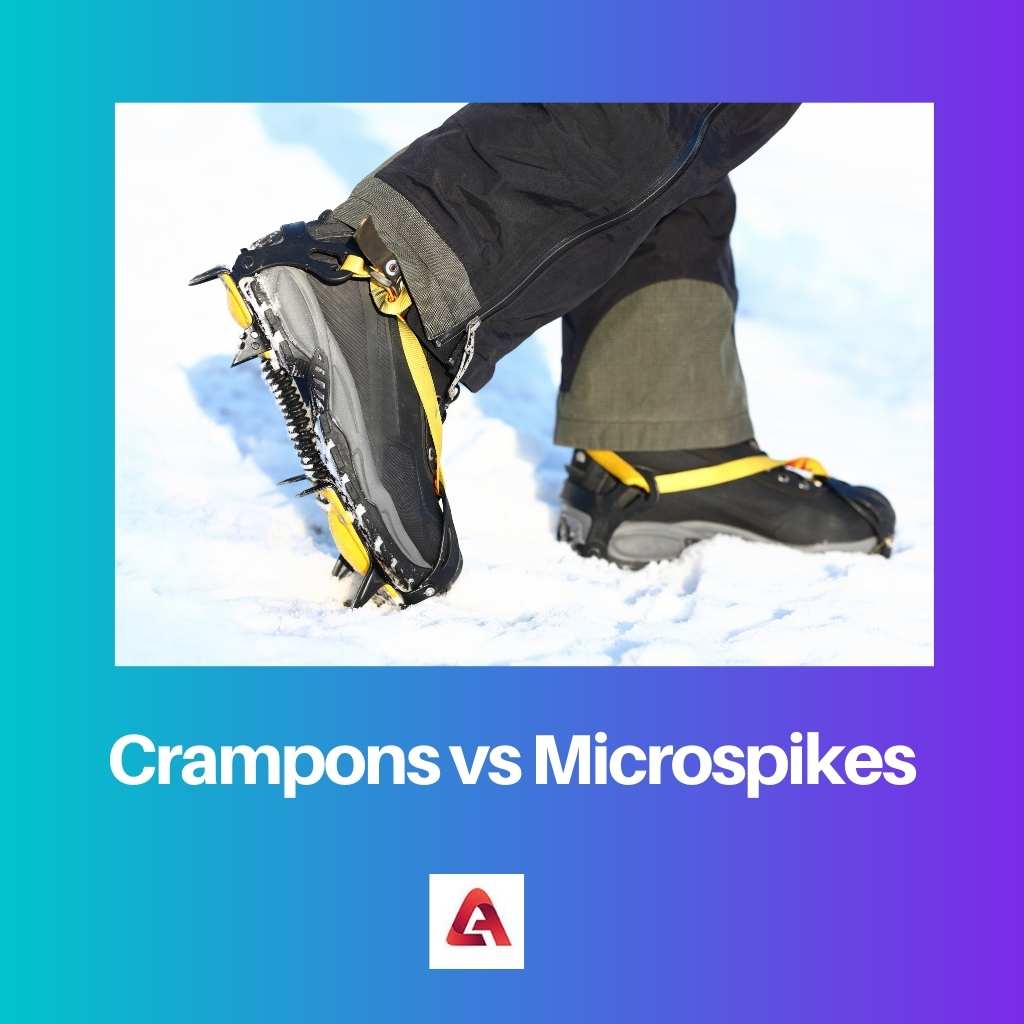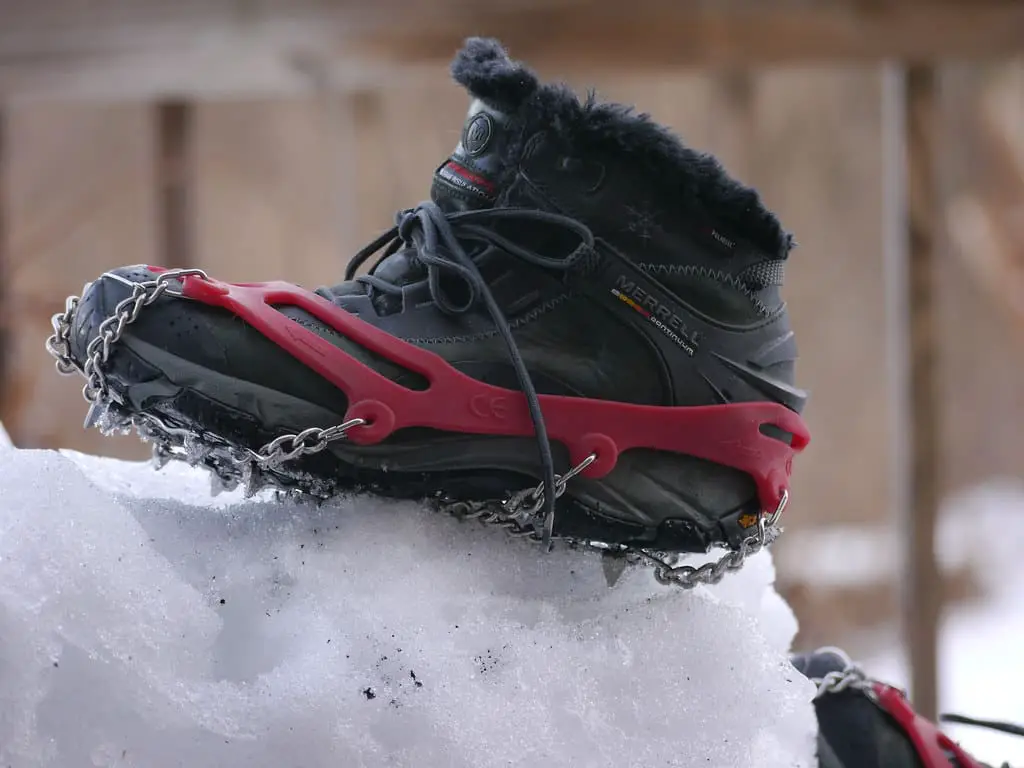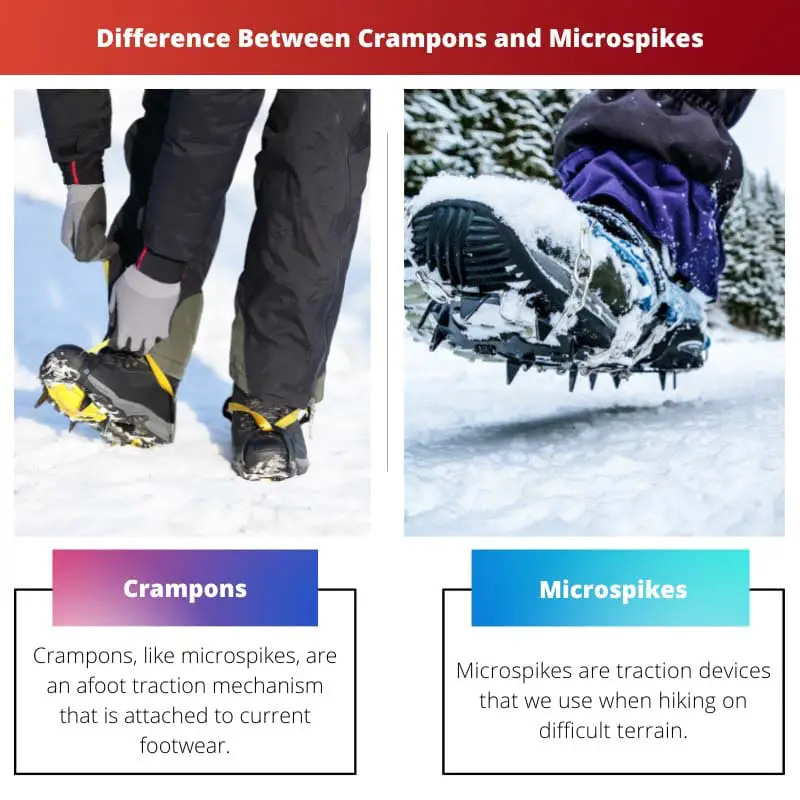Hiking in the winter needs more foot traction to avoid slipping on ice and snow. For icy or snowy circumstances, there are 3 kinds of footwear traction aids, each of which is ideal for a unique situation.
Crampons and microspikes are two of the kinds. Although they serve the same purpose, confused, crampons and microspikes vary in terms of uses and suitability, etc.,
Key Takeaways
- Crampons are designed for technical mountaineering and ice climbing, while microspikes are designed for walking and hiking on icy or slippery surfaces.
- Crampons have longer spikes and are more aggressive than microspikes, which have shorter spikes and are less aggressive.
- Crampons are attached to mountaineering boots, while microspikes can be attached to regular hiking shoes.
Crampons vs Microspikes
Crampons are more aggressive and are designed for use in mountaineering and ice climbing. They are also used in other activities such as glacier travel etc. Microspikes are made of rubber or elastomer with small metal spikes. Microspikes are easier to put on and take off than crampons.

Crampons, like microspikes, are an afoot traction mechanism that is attached to current footwear. Crampons are foot frames with huge spikes on the bottom, as opposed to microspikes.
They can be tied to the foot using a strapping system or attached to the foot with a tension lever. Certain crampons require particular boots with welts, but others can be fitted to most strong, ankle-length boots.
Microspikes are traction devices that we use when hiking on difficult terrain. For more traction, we put them over trekking shoes.
They are great for hiking on snowy or icy trails. Microspikes are distinguished by their microscopic spikes and chains. They are built in the same way as chains are used over tires to improve vehicle traction.
Comparison Table
| Parameters of Comparison | Crampons | Microspikes |
|---|---|---|
| What are they? | Foot frames with large spikes. | Traction footwear for adventurous trails |
| Uses | Climbing | Hiking, jogging, trekking, running, etc. |
| Bottom | Spikes | Chains and spikes |
| Affordability | Less affordable | More affordable |
| Suitable for | Extreme ice and snow | A small amount of snow and ice |
| Difficulty Level | High | Low |
What are Crampons?
Crampons are a type of foot frame with huge spikes on the bottom. Simply put, they are pointer versions of snowshoes and skies. They may dig into ice and snow because of their pointed form.
A crampon has 10-12 points on average. Some ice climbing crampons, on the other hand, can have up to 14 points. In general, 10 points face downwards, while 2 points stick out the front of crampons with 12 points.
Having front points is useful when climbing higher terrain. Crampons were created for ice climbing.
They are linked to footwear and assist the wearer in improving grip while traveling in hazardous ice and snow terrains such as snow slopes, ice fields, and glaciers. Crampons are used by hikers, climbers, and backpackers.
Steel and aluminum are the most common materials used to make crampons. Steel crampons are an excellent choice for general technical mountaineering in steep and cold terrain.
Aluminum crampons, on the other hand, are light and ideal for alpine climbing. However, if you use them on rocky terrain, they will quickly wear out. Crampons were traditionally intended for use while ice climbing.
Crampons are footwear attachments that help improve grip while crossing difficult ice and snow terrain such as glaciers, snow slopes, ice-covered boulders, ice fields, and snowfields.
Steel crampons are the best solution for general technical mountaineering in steep and cold terrain. Stainless steel frames provide the same benefits as steel crampons while also being corrosion resistant.
They are put on the sole’s outside edge, allowing for a more natural step while ascending steep icy slopes. Ice climbing and mountaineering crampons are heavier, with longer spikes and a more aggressive traction design.
Crampons also eliminate the need to cut stairs on many slopes. Ice pitons and carabiners are employed on particularly challenging snow and ice. When the pistons are driven in, they are allowed to freeze in place.

What are Microspikes?
Heat-treated stainless steel spikes and welded stainless steel chains are common features of microspikes.
The spikes are corrosion-resistant, sturdy, and fiercely sink into the icy surface, whereas the chains provide extra traction in the snow while being remarkably flexible.
Furthermore, microspikes are less expensive and can be worn with non-boot footwear like trail running shoes. You can even go for a jog or run while wearing microspikes.
They are also suitable for usage on muddy or rough trails. Microspikes, like crampons, are traction devices used to traverse difficult terrain.
They are made up of small spikes and chains that are placed over your mountaineering or trekking footwear to provide additional traction.
Microspikes are developed in the same way as chains are used across tires to improve vehicle traction.
Microspikes work well on level hiking trails that are coated with snow or ice. They provide more grip when your boots are unable to provide the traction required to tread certain surfaces.
Microspikes are made out of chains and little spikes that are slipped over your shoes to provide more traction. The design of microspikes is similar to that of chains placed over tires to improve traction.
The spikes themselves are 14 to 12 inches long, allowing the wearer to dig into ice surfaces and packed snow.
Microspikes are suited for flat terrain or low-angle slopes since the spikes are relatively short and situated at the inside area of the sole.
Hiking or running on reasonably even surfaces in packed snow or icy weather is the greatest application for microspikes.
Wearing microspikes adds weight to your feet, which may cause you to tire sooner. It’s best to wear microspikes only when conditions call for them, rather than wearing them for the entire trek. They are minuscule and may easily fit inside a bag.

Main Differences Between Crampons and Microspikes
- Crampons are foot frames that have spikes lined up against the bottom while microspikes are the traction devices meant for going through trails.
- Crampons are mainly used for climbing whereas microspikes are mainly used for hiking and trekking.
- Crampons have spikes at the bottom meanwhile microspikes have chains along with spikes.
- Crampons tend to be less affordable than microspikes.
- Crampons are best suited for extreme snow and ice whereas microspikes are best suited for little snow and ice.
- Crampons are difficult to use and may require training while microspikes are easy to use.

